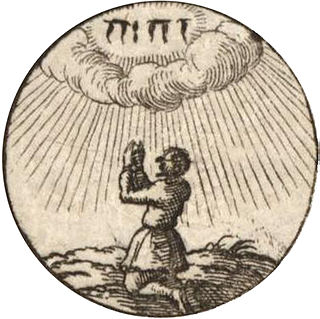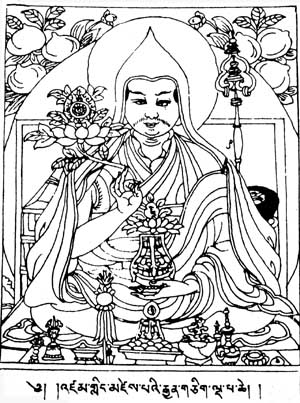
The temporal powerof the Holy See designates the political and secular influence of the Holy See, the leading of a state by the pope of the Catholic Church, as distinguished from its spiritual and pastoral activity.

The priesthood of all believers or universal priesthood is a biblical principle in most Protestant branches of Christianity which is distinct from the institution of the ministerial priesthood found in some other branches, including the Roman Catholic and Eastern Orthodox. Derived from the Bible and elaborated in the theology of Martin Luther and John Calvin, the principle became prominent as a tenet of Protestant Christian doctrine, though the exact meaning of the belief and its implications vary widely among denominations.
In Islam, Barakah or Baraka is a blessing power, a kind of continuity of spiritual presence and revelation that begins with God and flows through that and those closest to God.
Unam sanctam is a papal bull that was issued by Pope Boniface VIII on 18 November 1302. It laid down dogmatic propositions on the unity of the Catholic Church, the necessity of belonging to it for eternal salvation, the position of the Pope as supreme head of the Church and the duty thence arising of submission to the Pope to belong to the Church and thus to attain salvation. The Pope further emphasized the higher position of the spiritual in comparison with the secular order. The historian Brian Tierney calls it "probably the most famous" document on church and state in medieval Europe. The original document is lost, but a version of the text can be found in the registers of Boniface VIII in the Vatican Archives. The bull was the definitive statement of the late medieval theory of hierocracy, which argued for the temporal as well as spiritual supremacy of the pope.
A benefice or living is a reward received in exchange for services rendered and as a retainer for future services. The Roman Empire used the Latin term beneficium as a benefit to an individual from the Empire for services rendered. Its use was adopted by the Western Church in the Carolingian Era as a benefit bestowed by the crown or church officials. A benefice specifically from a church is called a precaria, such as a stipend, and one from a monarch or nobleman is usually called a fief. A benefice is distinct from an allod, in that an allod is property owned outright, not bestowed by a higher authority.

Church and state in medieval Europe was the relationship between the Catholic Church and the various monarchies and other states in Europe during the Middle Ages.

Qutb, Qutub, Kutb, Kutub or Kotb, means 'axis', 'pivot' or 'pole'. Qutb can refer to celestial movements and be used as an astronomical term or a spiritual symbol. In Sufism, a Qutb is the perfect human being, al-Insān al-Kāmil, who leads the saintly hierarchy. The Qutb is the Sufi spiritual leader that has a divine connection with God and passes knowledge on which makes him central to, or the axis of, Sufism, but he is unknown to the world. There are five Qutbs per era, and they are infallible and trusted spiritual leaders. They are only revealed to a select group of mystics because there is a "human need for direct knowledge of God".

Positive laws are human-made laws that oblige or specify an action. Positive law also describes the establishment of specific rights for an individual or group. Etymologically, the name derives from the verb to posit.

Figure with Meat is a 1954 painting by the Irish-born artist Francis Bacon. The figure is based on the Pope Innocent X portrait by Diego Velázquez; however, in the Bacon painting the Pope is shown as a gruesome figure and placed between two bisected halves of a cow.

The two kingdoms doctrine is a Protestant Christian doctrine that teaches that God is the ruler of the whole world and that he rules in two ways. The doctrine is held by Lutherans and represents the view of some Calvinists. John Calvin significantly modified Martin Luther's original two kingdoms doctrine and certain neo-Calvinists have adopted a different view known as transformationalism.
Henry of Segusio, usually called Hostiensis, was an Italian canonist of the thirteenth century, born at Susa (Segusio), in the ancient Diocese of Turin. He died at Lyon.
To the Christian Nobility of the German Nation is the first of three tracts written by Martin Luther in 1520. In this work, he defined for the first time the signature doctrines of the priesthood of all believers and the two kingdoms. The work was written in the vernacular language German and not in Latin.

"To Tirzah" is a poem by William Blake that was published in his collection Songs of Innocence and of Experience. It is often described as the most difficult of the poems because it refers to an oblique character called "Tirzah", whose identity is not directly stated. It is a Hebrew name that appears in the Torah, meaning "she is my delight". According to Northrop Frye, Blake identified the name Tirzah with worldliness, because the name appears in the Bible to refer to both a rebellious town and to one of the Daughters of Zelophehad. The latter story was about female inheritance rights which were linked to restrictions on marriage and the maintenance of tribal boundaries.
Libertas ecclesiae is the notion of freedom of religion of ecclesiastical authority of the Catholic Church from secular or the temporal power, which guided the Reform beginning in the 11th century.
Famuli vestrae pietatis, also known by the Latin mnemonic duo sunt, is a letter written in 494 by Pope Gelasius I to Byzantine Emperor Anastasius I Dicorus on the relationship between religious and secular officials.

The Dual System of Government is the traditional diarchal political system of Tibetan peoples whereby the Desi coexists with the spiritual authority of the realm, usually unified under a third single ruler. The actual distribution of power between institutions varied over time and location. The Tibetan term Cho-sid-nyi literally means "both Dharma and temporal," but may also be translated as "dual system of religion and politics."

Maqaam or maqaamat (plural), translating to "stations" in Arabic, is the various stages a Sufi's soul must attain in its search for Allah. The stations are derived from the most routine considerations a Sufi must deal with on a day-to-day basis and is essentially an embodiment of both mystical knowledge and Islamic law (Sharia). Although the number and order of maqaamat are not universal the majority agree on the following seven: Tawba, Wara', Zuhd, Faqr, Ṣabr, Tawakkul, and Riḍā. Sufis believe that these stations are the grounds of the spiritual life, and they are viewed as a mode through which the most elemental aspects of daily life begin to play a vital role in the overall attainment of oneness with Allah.

The Sun and Moon allegory is used to depict a medieval political theory of hierocracy which submits the secular power to the spiritual power, stating that the Pope is like the Sun i.e. the only source of his own light, while the Emperor is like the Moon, which merely reflects lights and has no value without the Sun. It was espoused by the Roman Catholic Church of Innocent III and instantiated to some extent in medieval political practice.
Miri-Piri is a concept that has been practiced in Sikh religion since seventeenth century. The concept of "The Mir and the Pir" was started by the sixth Guru of Sikhism, Guru Hargobind, on June 12, 1606. After the martyrdom of his father, Guru Hargobind ascended to the Guruship and fulfilled the prophecy that was given by primal figure of Sikh Baba Buddha that the guru will possess spiritual and temporal power. Guru Hargobind introduced the two swords of Miri and Piri symbolizing both worldly (political) and spiritual authority. The two kirpan of Miri and Piri are tied together with a khanda in center, so the combination of both is considered supreme, Where action informed or arising out of the spiritual heart completes one’s purpose and meaning in the world of action: spirituality.

In the Middle Ages, hierocracy or papalism was a current of Latin legal and political thought that argued that the pope held supreme authority over not just spiritual, but also temporal affairs. In its full, late medieval form, hierocratic theory posited that since Christ was lord of the universe and both king and priest, and the pope was his earthly vicar, the pope must also possess both spiritual and temporal authority over everybody in the world. Papalist writers at the turn of the 14th century such as Augustinus Triumphus and Giles of Rome depicted secular government as a product of human sinfulness that originated, by necessity, in tyrannical usurpation, and could be redeemed only by submission to the superior spiritual sovereignty of the pope. At the head of the Catholic Church, responsible to no other jurisdiction except God, the pope, they argued, was the monarch of a universal kingdom whose power extended to Christians and non-Christians alike.










